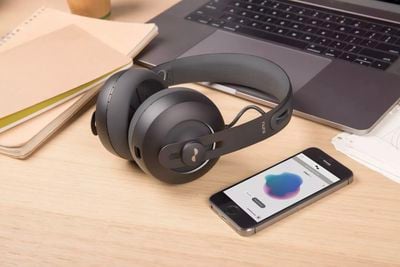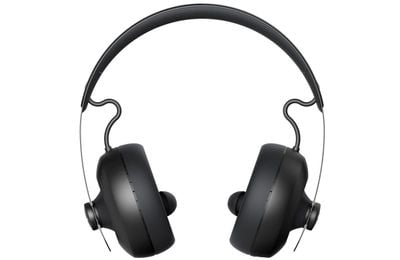The Nura headphones were funded on Kickstarter last year, surpassing a $100,000 goal and earning around $1.8 million from backers who were interested in the device's personal music calibration abilities. Today, the company is officially launching the $399 "Nuraphone" to backers from the Kickstarter campaign and to any new buyer through its website, with a pair of headphones that use a self-learning engine to automatically adjust to your own "unique hearing" and ensure each song you listen to is the highest quality possible (via The Verge).
Nuraphone plays a range of tones into your ear, measuring a faint sound that your ear generates in response to the tones, and this process begins the calibration of the headphones to your own profile. The returning sound is "encoded" with data about how well you heard the noise that entered your ear, with the device's self-learning engine analyzing the information and creating a custom "hearing profile" with a unique color and shape. All of this happens in approximately 60 seconds.

Once your hearing profile is in shape, Nuraphone filters all music playback through your profile settings to "sonically mold" and adjust songs and deliver a greater degree of detail. Nura CEO Kyle Slater told The Verge that the Nuraphone is meant to "do for your ears what glasses do for your eyes."
Kyle Slater, Nura’s CEO, compares what the Nuraphones do for your ears to what glasses do for your eyes. They’re supposed to figure out which frequencies of sound you’re good at and not so good at hearing, and then mess with the amplification so that you hear every song precisely how it was mixed. “We assume that we all hear the same,” Slater says. “Hearing offers no point of comparison like vision does.” Our hearing gradually degrades as we age (and listen to loud music...), so it’s reasonable to think a lot of people could use this
Once connected to an iPhone or Android smartphone through Bluetooth (the headphones also support Lightning, USB-C, micro-USB, and 3.5mm analog cables), Nuraphone can begin playing and adjusting songs to your hearing profile. Nura has decided to use a proprietary charging cable, meaning to use any of these wired connections you'll have to buy extra accessories from the company (one USB cable is included in the box).

The headphone's design is that of an over-ear headphone mixed with in-ear buds, and on the outside there is a programmable touch panel for controlling features like playing and pausing songs.
A few sites have gotten to go hands-on and review Nuraphone, mostly coming to the consensus that Nura has taken a unique approach to designing headphones and providing a new user experience, but the first iteration of the product is still lacking. The Verge pointed out that someone with hearing issues could see great benefits from using Nuraphone, "but the end result isn't as revolutionary as the general idea."
But my initial impression is that the sound improvement isn’t night and day over other pricey headphones. Maybe the difference would be larger for someone who Nura detected more hearing issues with — though there’s no way of telling whether Nura is doing a little or a lot for me. (I tried listening to high-pitched sounds that I can’t or can barely hear, but Nura didn’t seem to help me hear them substantially better.) I like the effect the headphones create when playing music, but the end result isn’t as revolutionary as the general idea.
TechRadar mentioned that the fundamentals for a quality set of headphones are there, but the "benefits of sound personalization are subtle" and the user experience is sometimes "over complicated." Despite a few design quirks, Engadget called the headphones "impressive" and "polished," saying that that they will "likely only get better" through software updates.
Nuraphone is available to purchase today on Nura's website for $399, including a case for the headphones and a USB charging cable.
























Top Rated Comments
As a former musician and studio engineer, I can tell you that the mixing process is one where many compromises are made so that "on average" it will sound balanced on the wide range of equipment that it will be listened to on.
These phrases assume that that an artist is expecting it to sound exactly one way. A majority of albums have been mixed on Yamaha NS-10s which are extremely flat, but horrible sounding. After we would get a mix the artist always wants to hear it on the huge monitors, which are not flat because they sound awesome.
I don't want a flat experience, I want something that makes the music sound good and punchy when I'm listening for enjoyment. Not a flat experience like I would have in front of a mixing console.